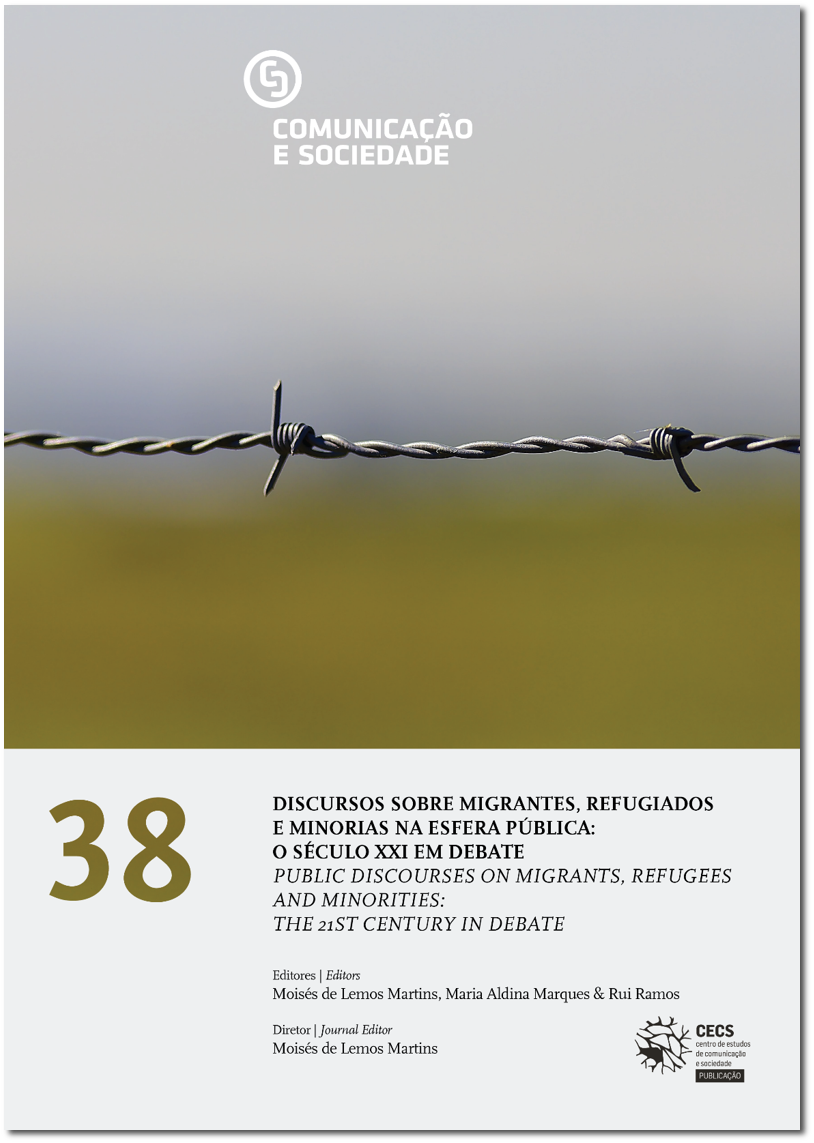The refugee crisis: narrative sequences and emotions in opinion articles/reports or narratives in the service of persuasion
DOI:
https://doi.org/10.17231/comsoc.38(2020).2595Keywords:
linguistic empathy, persuasion, narration, refugees, mediaAbstract
We intend to show, using an ad hoc corpus of media texts on the refugee crisis, how several linguistic and, more specifically, enunciative-pragmatic mechanisms contribute to the construction of an empathic discourse, used for argumentative purposes. These journalistic texts, between opinion and reporting, take sides, although not through a set of logical arguments objectively arranged and assumed by the speaker, but, instead, through narratives that show refugees as a source of information either as protagonists or, sometimes, as initial narrators. Through these narratives, the speaker seeks to approach the tragic experience told by refugees and bring it to the reader, with the aim of conquering his empathy (Lencastre, 2011). The linguistic empathy (Rabatel, 2017) translates into enunciative mechanisms, such as placing yourself in someone else’s place, assuming her voice, to understand her point of view. The narrative, descriptive and dialogical sequences (Adam, 2005) are at the service of this empathy, through which the speaker tries to persuade the addressee. Several mechanisms will be listed that contribute to the same discursive strategy of persuading the addressee, through discourse patemization. We conclude that emotion in discourse (Plantin, 2011) that favours empathy increases when done through the voice of people with names and stories located in spaces that can be described, using reported speeches, narratives and descriptions for the construction of the theses defended by the journalists.
Downloads
References
Adam, J-M. (2005). La linguistique textuelle: introduction à l’analyse textuelle des discours. Paris: Armand Colin.
Benveniste, É. (1966). Problèmes de linguistique générale. Paris: Gallimard.
Charaudeau, P. & Maingueneau, D. (2004). Dicionário de análise do discurso. São Paulo: Contexto.
Dahlet, P. (2016). O discurso político e o sujeito coletivo: fachadas do nós. In W. Emediato (Ed.), Análise do discurso político (pp. 214-240). Belo Horizonte: Editora FALE/UFMG.
Dicionário da Língua Portuguesa Contemporânea (2001). Academia das Ciências. Lisboa: Verbo.
Duarte, I. M. (2015). Conhecer gentes e as suas histórias: a narrativa como forma de persuasão. In M. Pinto; S. Pereira & M. J. Brites (Eds.), Os media e a crise dos refugiados, agenda de atividades (pp. 15-16). Braga: Centro de Estudos de Comunicação e Sociedade (CECS), Universidade do Minho.
Ducrot, O. (1985). Le dire et le dit. Paris: Les Éditions de Minuit.
Hattnher, M. M. (2018). A expressão lexical da evidencialidade: reflexões sobre a dedução e a percepção de evento. Entrepalavras, 8, [n. especial], 98-111. http://doi.org/10.22168/2237-6321-6esp1244
Kerbrat-Orecchioni, C. (1980). L’énonciation. De la subjectivité dans le langage. Paris: Armand Colin.
Krieg-Planque, A. (2009). La notion de “formule” en analyse du discours. Cadre théorique et méthodologique. Besançon: Presses Universitaires de Franche-Comté.
Kronning, H. (2012). Le conditionnel épistémique: propriétés et fonctions discursives. Langue française, 173, 83-97. https://doi.org/10.3917/lf.173.0083
Lencastre, M. (2011). Empatia, teoria da mente e linguagem. Fundamentos etológicos, psicológicos e culturais dos valores. ANTROPOlógicas, 12, 9-18.
Mais de 20 mil migrantes morreram em travessias no Mediterrâneo desde 2014 (2020, 06 de março). ONU News. Retirado de https://news.un.org/pt/story/2020/03/1706451
Manuel, A. (2011). Information d’urgence et information télévisée: analyse d’un paradigme communicationnel (les événements du tsunami de 2004 et du 11 septembre 2001. Tese de Doutoramento, Université de Besançon, Franche-Comté, Besançon, França. Retirado de https://tel.archives-ouvertes.fr/tel-00973871/
Plantin, C. (2011). Les bonnes raisons des émotions. Principes et méthode pour l’étude du discours émotionné. Berne: Peter Lang.
Prince, G. (1978). Le discours attributif et le récit. Poétique, 35, 305-313.
Público. (2005). Livro de estilo (2.ª ed.). Lisboa: Público, Comunicação, S.A.
Rabatel, A. (2013). Ecrire les émotions en mode emphatique. Semen, 35. https://doi.org/10.4000/semen.9811
Rabatel, A. (2017). Empathie et émotions argumentées en discours. In A. Rabatel (Ed.), Pour une lecture linguistique et critique des médias. Empathie, éthique, point(s) de vue (pp. 265-276). Limoges: Lambert-Lucas.
Rota do Mediterrâneo é a mais perigosa e já matou mais de mil migrantes este ano (2019, 07 de outubro). Observador. Retirado de https://observador.pt/2019/10/07/rota-do-mediterraneo-e-a-mais-perigosa-e-ja-matou-mais-de-mil-migrantes-este-ano/
Salvan, G. (2005). L’incise de discours rapporté dans le roman français du xviiie au xxe siècle: contraintes syntaxiques et vocation textuelle. In A. Jaubert (Ed.), Cohésion et cohérence: études de linguistique textuelle. Lyon: ENS Éditions. https://doi.org/10.4000/books.enseditions.144
Zhang, G. (2015). Elastic language. How and why we stretch our words. Cambridge: Cambridge University Press.
Downloads
Published
How to Cite
Issue
Section
License
Copyright (c) 2020 Comunicação e Sociedade

This work is licensed under a Creative Commons Attribution-NonCommercial 4.0 International License.
Authors own the copyright, providing the journal with the right of first publication. The work is licensed under a Creative Commons Attribution 4.0 International License.












